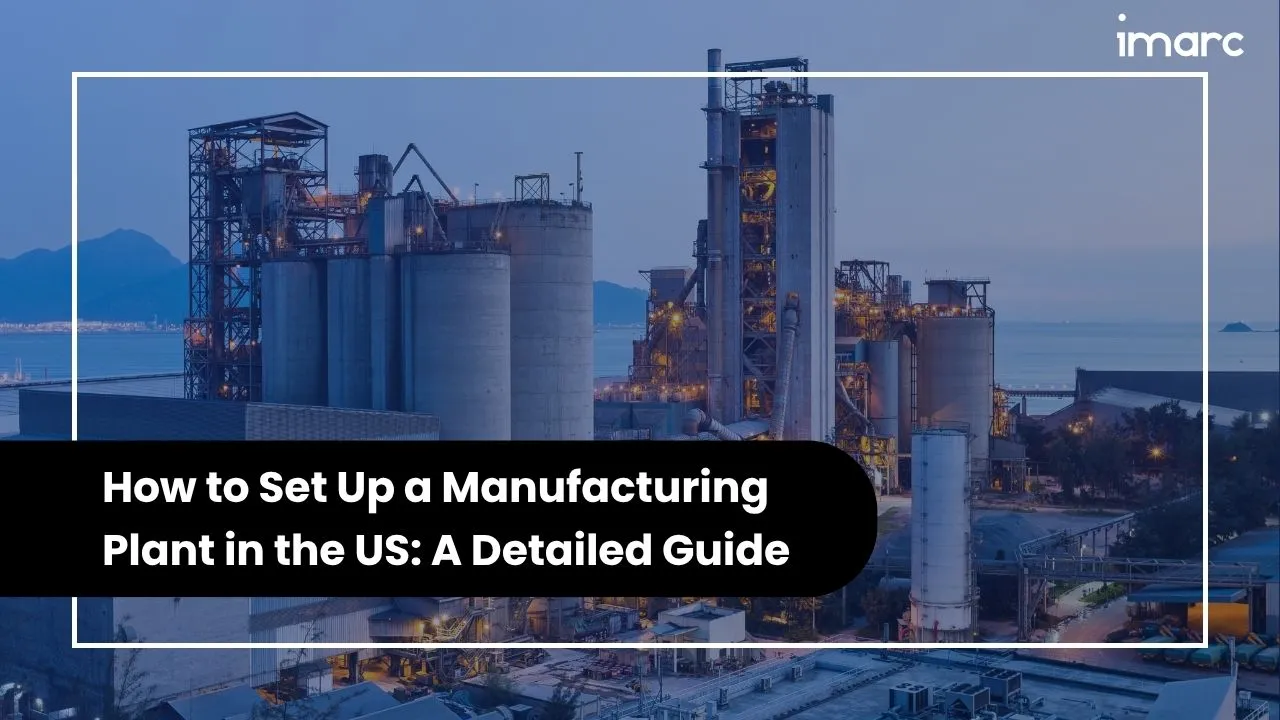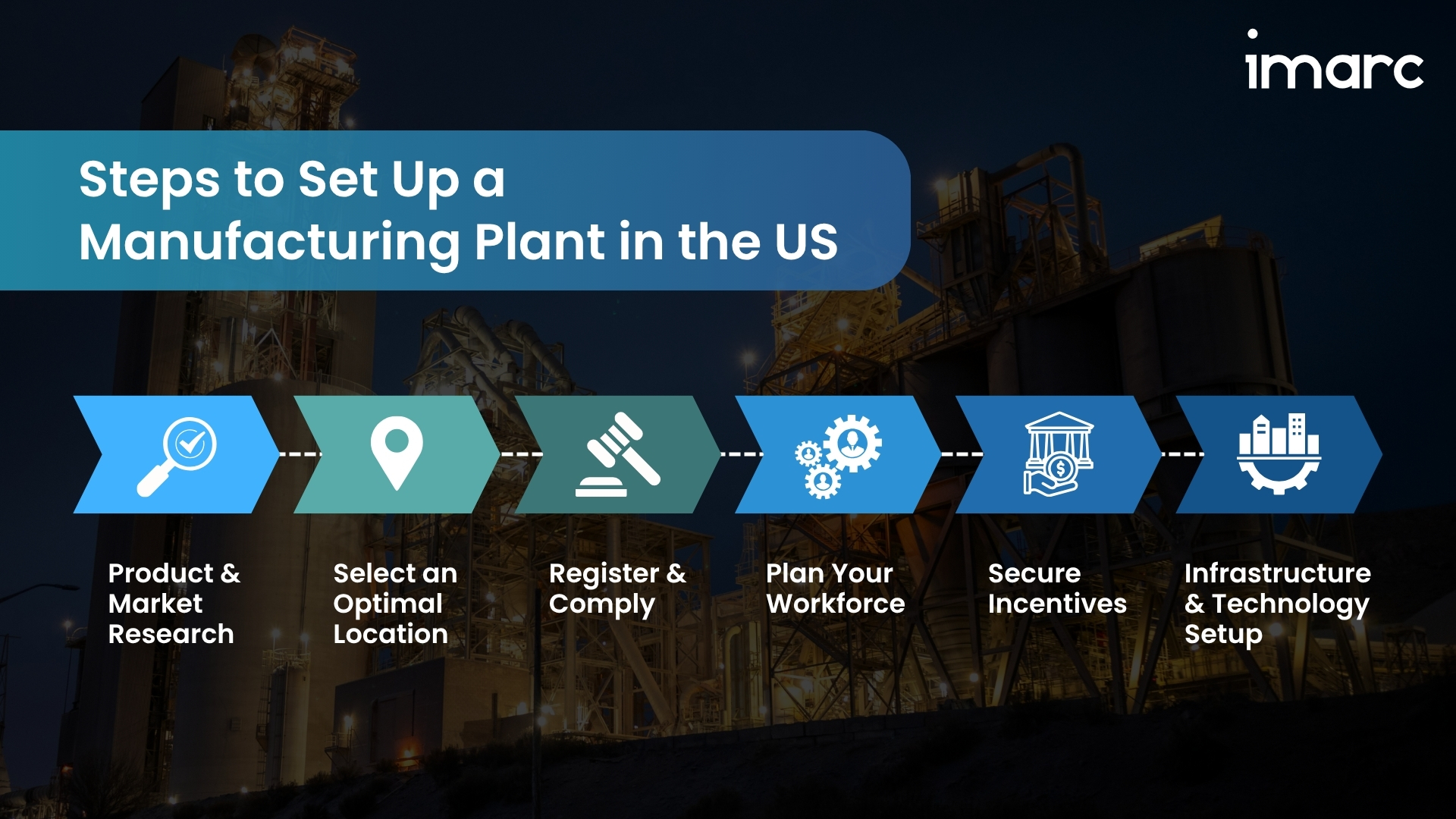How to Set Up a Manufacturing Plant in the US: A Detailed Guide

Expanding into the United States can be a strategic move for manufacturers looking to tap into one of the world's largest markets. With robust infrastructure, federal incentives, and vast market opportunities, the US remains an attractive destination for establishing a manufacturing plant. However, setting up a manufacturing operation requires careful planning, significant financial investment, and a clear understanding of the US market dynamics. This guide outlines the essential considerations and procedures for setting up a manufacturing plant in the US, with a focus on realistic timelines, strategic decisions, and navigating common challenges.
Why the United States Is a Prime Location for Manufacturing:
Re-Emerging as a Global Manufacturing Power
In recent years, the United States has been steadily regaining its position as a global manufacturing leader. Public and private investment, technological innovation, and strategic reshoring efforts have driven this resurgence. As of March 2024, capital investments from international firms in the US manufacturing sector have surged, with over USD 200 Billion committed since 2021 to projects in semiconductors, electric vehicles, and green technologies.
US Tariffs Sparking Hope for Domestic Manufacturing
Introduced in April 2025, new tariffs on imported goods, while raising costs for businesses using foreign parts and potentially increasing consumer prices, offer a significant positive impact for US manufacturing. By making imports more expensive, these measures aim to boost the competitiveness of domestically produced goods. This could incentivize companies to shift production back to the United States, fostering job creation and strengthening local supply chains, despite the immediate challenges of higher input costs. The move underscores a governmental push towards enhancing domestic industrial capacity.
For example, the US president's tariffs are actively driving a surge in domestic manufacturing, with numerous companies announcing multi-billion-dollar investments in new US facilities and expanded production. Giants like TSMC, NVIDIA, Apple, and Hyundai are committing significant capital, aligning with the administration's goal of restoring American industrial strength. This strategic shift is creating new opportunities, strengthening local supply chains, and potentially revitalizing regions through increased domestic production.
Key Advantages of Setting Up a Plant in the US:
1. Federal and State Incentives
The US federal government, along with state economic development agencies, offers a wide range of support programs:
- CHIPS and Science Act: Over USD 52 Billion allocated to semiconductor research and manufacturing.
- Inflation Reduction Act (IRA): Up to USD 370 Billion in tax credits and subsidies for green manufacturing, including EVs, batteries, and solar panels.
- State-Level Incentives: Texas, Ohio, Georgia, and South Carolina provide land subsidies, tax abatements, and workforce training grants through local development corporations.
2. High-Quality Infrastructure
Manufacturers in the US benefit from access to one of the world’s most integrated infrastructure systems, spanning railways, highways, ports, and energy grids. Investment in clean energy, 5G networks, and broadband connectivity is also enhancing manufacturing zones in both urban and rural regions.
3. Skilled and Productive Workforce
The US labor force includes a large pool of technicians, machinists, and engineers. Over 13 million Americans were employed in manufacturing as of Q2 2024, with thousands entering through trade schools and federally funded apprenticeships each year.
4. Legal Protection and IP Security
The US offers some of the strongest intellectual property protections globally, ensuring the security of proprietary technologies, patents, and trademarks. These safeguards are a key concern for high-tech and pharma companies entering the market.
5. Domestic Demand and Export Access
With over 330 million consumers and trade access to Mexico, Canada, and over 20 FTA countries, manufacturers have broad market access. The US is also increasingly focusing on domestic supply chains to reduce dependence on imports from geopolitical hotspots.
Core Manufacturing Sectors in the US:
The US manufacturing environment is shaped by strategic industries experiencing massive investment and policy support.
- Semiconductors: Semiconductor fabs are under construction or expansion in Arizona, Texas, New York, and Ohio. Intel, TSMC, and Samsung are collectively investing over USD 100 Billion in new fabrication plants to meet domestic and global demand. The CHIPS Act has created a robust ecosystem for chip manufacturing and supply chain localization.
- Electric Vehicles and Batteries: Tesla’s gigafactories in Nevada and Texas, Ford’s BlueOval City in Tennessee, and Hyundai’s plant in Georgia highlight the scale of US EV production. Battery supply chains are also expanding rapidly, with over 30 gigafactories planned or operational as of 2025.
- Aerospace and Defense: US firms dominate the global aerospace and defense manufacturing market. Boeing, Lockheed Martin, and Northrop Grumman continue to lead, backed by Department of Defense funding and policies that support local content sourcing and innovation.
- Pharmaceuticals and Biotechnology: The US is a global hub for drug discovery and advanced manufacturing. Pfizer, Moderna, and Amgen are investing in facilities focused on biologics and mRNA platforms. FDA’s Emerging Technology Program and advanced manufacturing initiatives support fast-tracked approval processes.
- Renewable Energy: The US solar and wind energy sector has grown with IRA incentives. First Solar is expanding US production capacity, while Vestas and Siemens Gamesa are building wind turbine components domestically. Hydrogen and battery storage are also gaining momentum.
- Industrial Machinery and Robotics: With companies like Emerson, Rockwell Automation, and Honeywell, the US is a hub for advanced control systems, industrial IoT, and smart robotics for smart factories.
Step-by-Step Process to Establish a Manufacturing Plant in the US:
Realistic Timeline: From Groundbreaking to Production
The timeline for setting up a manufacturing plant can vary depending on the complexity of the project, industry sector, and geographical location. Below is a general breakdown of timelines for different types of manufacturing facilities:
- 18–36 Months (Standard Projects): General manufacturing plants such as those in food processing or textiles typically take around 18-36 months, considering construction and equipment setup.
- 12–18 Months (Fast-Track Projects): Smaller or modular facilities, often using prefabricated units, can be set up faster, especially if retrofitting existing spaces.
- 24–48 Months (Complex, Large-Scale Plants): High-tech industries, like aerospace and semiconductors, may require longer due to specialized equipment and safety standards.
Steps for Setting Up a Manufacturing Plant:
- Product and Market Research
Evaluate market demand, regulatory requirements, and competitive landscape. Utilize data from government agencies like the US Census Bureau, SelectUSA, and industry associations to conduct feasibility studies.
- Select an Optimal Location
Consider proximity to suppliers, logistics, labor availability, energy costs, and environmental regulations. Locations in Foreign Trade Zones (FTZs) may offer logistical advantages.
- Register and Comply
Form a legal entity (e.g., LLC, C-Corp) and secure necessary licenses and permits, including an EIN, local business licenses, environmental permits, and OSHA safety compliance.
- Plan Your Workforce
Partner with local technical colleges and state workforce boards for training opportunities. Explore federal programs like the Workforce Innovation and Opportunity Act (WIOA) for additional funding.
- Secure Incentives
Work with local economic development corporations and regional government bodies to secure tax credits, low-interest loans, and other incentives.
- Infrastructure and Technology Setup
Integrate ERP and MES systems, robotics, and automation into your operations. Consider implementing predictive maintenance tools and AI/ML for supply chain optimization.

Common Challenges When Setting Up in the US
- Regulatory Complexity:
Navigating the US regulatory landscape can be complex. Federal, state, and local laws may vary, requiring careful planning and legal consultation. Understanding compliance with federal, state, and local laws is crucial, including antitrust, consumer product safety, and workplace health and safety regulations.
- Labor Shortages and High Labor Costs:
The US is experiencing labor shortages, particularly in manufacturing sectors that rely on unskilled workers. The competition for labor has led to rising wages, which can increase operational costs.
- Higher Capital Costs:
While US manufacturing offers numerous benefits, capital expenditure (CAPEX) may be higher compared to other regions globally. However, the increased productivity, incentives, and legal protections may offset these higher costs.
- IP Protection:
Protecting intellectual property in the US is essential. Register patents, trademarks, and copyrights in the US to ensure legal enforcement. Monitoring for potential IP infringements is also a critical part of managing your US operations.
How IMARC Can Support Your US Manufacturing Expansion
At IMARC, we specialize in providing end-to-end support for setting up manufacturing plants in the US. Our services include:
Market Research and Strategic Insights: Building a successful manufacturing operation in the US goes beyond just establishing the plant; it requires in-depth knowledge of local market trends, consumer behaviors, and competition. IMARC Group offers:
- Comprehensive market research to uncover demand patterns and emerging growth opportunities.
- Strategic insights to help position your products in a competitive US market.
- Support in identifying reliable suppliers and effective distribution channels.
Comprehensive Pre-Feasibility Studies: We recognize that every manufacturing project in the US has its own set of challenges. Our pre-feasibility studies offer a thorough analysis of essential factors such as:
- Market feasibility and demand projections.
- Cost assessments covering land, construction, machinery, and more.
- Location analysis based on logistics, workforce availability, and infrastructure.
Assistance in Location Selection: The US offers a wide variety of locations with different economic advantages. IMARC’s experts will guide you in choosing the optimal location for your manufacturing plant, considering:
- Proximity to suppliers and customers.
- Access to transportation networks and tax incentives.
- Labor availability and operational costs.
Cost Estimation and Financial Analysis: We provide detailed financial breakdowns to help you plan effectively. Our analysis includes:
- Land acquisition and facility construction costs.
- Machinery, equipment, and technology expenses.
- Labor, utility, and maintenance costs.
- Ongoing operational and regulatory compliance costs.
Regulatory Compliance and Licensing: Navigating the complex regulatory environment in the US is crucial to the smooth setup of a manufacturing plant. IMARC will assist you with:
- Understanding federal and state regulations for manufacturing operations.
- Securing necessary permits, licenses, and certifications.
- Ensuring compliance with labor laws, environmental regulations, and safety standards.
Final Thoughts
Setting up a manufacturing plant in the United States presents significant growth opportunities, but it requires a careful balance of strategic planning, legal compliance, and market analysis. By leveraging federal incentives, securing the right location, and addressing labor challenges, manufacturers can navigate the complexities of US expansion successfully.
IMARC is here to guide you every step of the way, from site selection to full plant operation. Let us help you make your US manufacturing expansion a reality.
Our Clients
Contact Us
Have a question or need assistance?
Please complete the form with your inquiry or reach out to us at
Phone Number
+91-120-433-0800+1-201-971-6302
+44-753-714-6104










